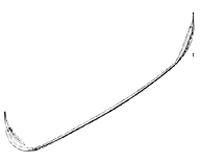|
This type of construction is very specialized and requires wood working skills far more than a caravel vessel would. In addition, this type of
construction is very wasteful of wood since almost all of the structural members, including the strakes, are carved and shaped using axes and adzes
instead of using sawn timbers.
|
|
Building the Hull
|

|
Laying the Keel:
The first stage consisted of laying the keel, usually a single piece of timber cut from a tree-trunk. In Ivinia the keel is almost always
made of oak, in other regions elm is also used in place of oak. The ideal keel is usually straight, with no curvature. When the required
length of timber cannot be found, two pieces are then scarfed together to achieve the required length. This was usually avoided since the
scarf would be a potential area of weakness. The keel itself has a cross-section that is T-shaped, the top portion creating
a flange to which the lowest runs of strakes are attached. Some keels have parallel sides, while others are wider in the middle and taper
towards their ends; the stem and sternposts being scarfed to the ends of the keel. The
posts, and other curved pieces in the vessel, are chosen from grown timbers that have the grain following the long curve of each component
in order to provide strength. Both posts were often of two pieces scarfed together. Some posts even have false strakes cut out of the solid
wood to provide a secure fastening point. However, most posts do not have these embellishments and are plain or have a notch cut into them
for receiving the strakes. The entire keel is placed on blocks to keep it level and spares are placed under the posts to support them.
|



|
Straking the Hull:
Once the keel is laid, the next step involves placing the strakes. Strakes are made from radially spilt oak trunks or
tangentially split softwoods. They are then shipped using axes and scrapers. The first strake on each side of the keel is attached to the
keel’s top flange. It usually takes more than one plank to form a strake, in this case the ends of the planks are scarfed together in
order to make them long enough. The ends of the planks are then tapered so that the overlapping at the scarf is not thicker than the planks
themselves. Additional strakes are laid until the bottom of the vessel is completed to the turn of the bilge. As each
strake is laid a layer of caulking material is placed in between the overlap of the previous strake. Each set of strakes
are fastened to the previous strake, the keel, or the end post using iron clench nails which are hammered through partially
pre-bored holes. The ends of each nail being hammered over a rove on the inboard side of the vessel.
After the bottom strakes have been put into place the floor timbers are inserted at regular intervals perpendicularly
across the bottom strakes and keel. These timbers are made from crooks that follow the run of the grain. The undersides of the timbers are
cut so that they fit the irregular shape of the vessel’s bottom caused by the overlapping of the strakes allowing them to maintain
contact with the bottom timbers as much as possible. The floors are fastened to the strakes by wooden pegs known as
treenails and only rest on the keel. The treenails are inserted from outboard to inboard through augured holes.
Once the floors are in place, more strakes are added to form the sides of the vessel. After two or three strakes are added, additional
framing timbers, called futtocks, are added. These are scarfed to the floor timbers and attached to the side strakes just
as the floors were attached to the bottom strakes. A large vessel would add an additional tier of strakes and futtocks to the sides. Vessels
receive lateral support by means of horizontal cross-beams secured atop the futtocks. It is common practice to have these beams pierce the
side of the vessel, using the strakes and the futtocks as a means to lock them into place. Longitudinal stiffness is provided by a
keelson placed over the keel and stringers are laid along the inside face of the strakes. Finally
breasthooks at the bow and stern are used to hold the ends together.
|
| |
|
|
Rigging and Outfitting
|

|
Rigging:
Rigging starts with mounted a mast along with its lines and cables, mast crutches and yardarm. The mast is usually made from a single
timber, pine being a typical choice because of its ability to grow straight and tall. Sails are usually made of canvas or wool, wool being
the choice of Ivinian sailors and shipwrights. Rigging consists of ropes and cables of various lengths and thickness and are used to keep
the mast and yard in place while sailing.
Outfitting:
The final stage of building includes adding decking to the fore and aft sections; the center section or hold being left uncovered for
merchantmen and covered for fighting ships. If needed, rowing benches are installed. A steering oar is mounted to the starboard aft side of
the vessel.
In port the yardarm can be used as a crude crane. Some vessels may have a horizontal windlass on board to facilitate raising the anchor or
the yard, usually only on the largest of vessels.
Oars are made of ash and place through holes bored into one of the upper strakes to act as oar-locks. When not in use the holes are covered
by a wooden disk or plugged to prevent water from shipping in when under sail. Additional fitting out of the vessel is up to the personal
tastes of its owner and/or captain.
|
|